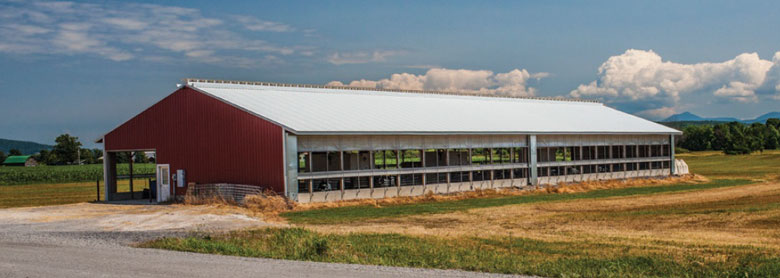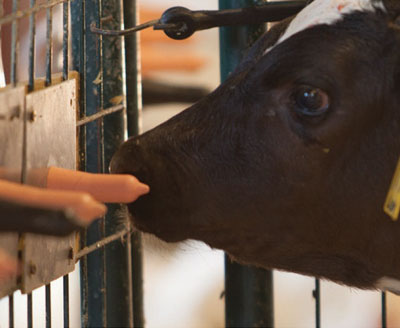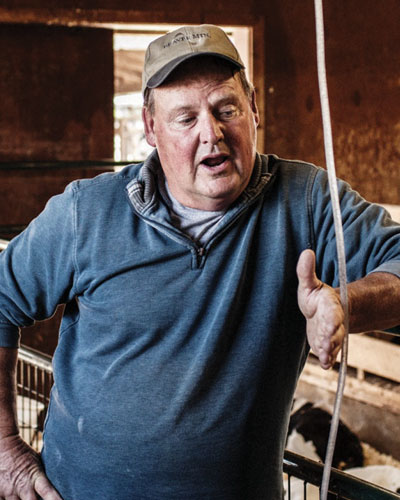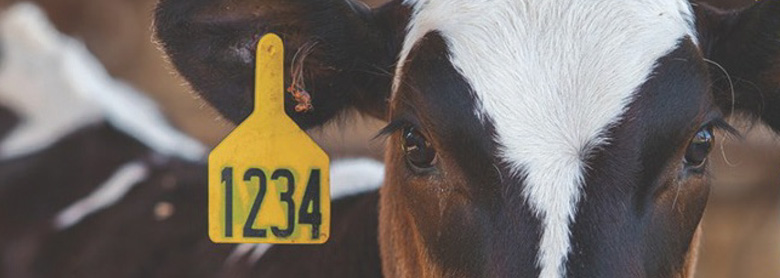Calf rearing on a dairy farm is one of the most important daily tasks on the farm. Customarily, calves tend to be reared individually in pens and hutches or small calf houses. This system has been historically successful for a couple of different reasons. The first is that it provides time for individual observations for each calf, as well as minimizing the risk of cross contamination between calves, especially in cases when you have an ill calf. It is, however, one of the most labor intensive tasks on the farm.
There are two more recent trends in calf rearing that are now gaining steam. Depending on your personal preference, either may appeal to you. Both have shown positive results in the health and growth of calves, which should pay dividends down the road when these cows come into production. We took a look at both methods and break them down for you here.
We visited with Eric Clifford and Charlene Phelps at the Clifford Farm in Starksboro, Vermont, where we examined the first method on our list: Gang or Batch Feeding. The Clifford farm is a closed farm and herd which prides itself on raising all its own replacement stock. Run by 8th generation farmer, Eric Clifford, the farm manages 235 head producing approximately 28,000 pounds of milk per cow. Managing Eric’s calf program is Charlene Phelps. Charlene has been raising Eric’s calves for 35 years. She and her twin granddaughters, Alison and Haley—who’ve been helping with the calves every summer since they were old enough—handle all the feedings and calf care.

The Clifford Farm converted to batch/gang feeding approximately two years ago. They use a non-automated feeding system that Charlene as perfected over the last two years. Charlene feeds her calves by using a steel, 50-gallon drum lined with heavy duty plastic, which Charlene meticulously keeps clean. The drum is rigged with an external heater that keeps it from freezing in the winter, and an aquarian air bubbler to keep the milk from settling or clumping. Clifford Farm uses Pinnacle Milk Replacer by Phoenix Feeds & Nutrition, which they decided upon after experimenting with several different formulas. When Charlene and Eric first started batch feeding, they used an acidified milk replacer, but they noticed it irritated the calves’ throats, resulting in coughing. They then switched to Pinnacle and have had no health issues at all since switching.
Gang Feeding is a method of calf feeding that keeps the calves together in cohort groups, mainly grouped according to age. These groups are allowed to socialize within a few days of being born and moved to the calf barn from individual pens. Being allowed to socialize at this early age allows the animals to learn social and herd dynamics right from the start, something missing from traditional calf feeding. This is a vastly important behavior that is lost when calves are not raised in groups, and has to be learned much later when calves are brought back together after being weaned. By allowing the animals to socialize at the start, they learn the social skills they need for later herd integration.
This early interaction also provides opportunity for early competition between individuals. Gang feeding allows for the animals to compete for nipples at the feeding station. Even though there’s a nipple for each animal, they still bump and shove for the preferred nipples. This competition and early socializing seems to promote healthier and heartier calves.
 Eric says the method has worked very well for them. It’s initially a larger investment in their calves, but this calf program actually lowers the costs of their heifers down the road. By growing bigger and more robust calves, the animals have more feed capacity as heifers. This translates into a more desired growth rate from a high forage diet at a lower cost.
Eric says the method has worked very well for them. It’s initially a larger investment in their calves, but this calf program actually lowers the costs of their heifers down the road. By growing bigger and more robust calves, the animals have more feed capacity as heifers. This translates into a more desired growth rate from a high forage diet at a lower cost.
Charlene also starts the calves with unlimited access to grain and hay right off the bat. Not only does this help the calves transition smoothly from milk replacer on to solids, but it also helps with keeping the calves from suckling on each other. The access to roughage keeps their mouths busy and the calves from getting bored, again translating into healthier animals.
The second method we’re highlighting is automated or robotic calf feeding. For our next stop, we visited Bret Danyow at his farm in Ferrisburgh, Vermont, and spoke with him about his automated calf feeding system. Bret switched to robotic feeders about the same time that the Clifford Farm switched over to batch feeding, just about two years ago. Bret is—for the most part—usually, happy with the results. Like anything new, the system had some kinks to work out, but most days the system is operating the way it’s supposed to, which makes caring for the calves much more streamlined.
Robot feeders are making calf rearing easier and less labor intensive on some farms. Non-automated systems require intensive management and observation. In non-automated calf rearing programs, individual intake can be difficult to monitor and record. With robotic feeders, each individual calf’s intake is monitored, which makes spotting much easier, and allows farmers to catch any struggling individuals much faster. Automated systems can also be managed by fewer individuals logging significantly fewer hours.
On the Danyow Farm, calves are all ear tagged with chips that are “recognized” by the robotic feeders, which then log the number of times that a calf feeds, how long they feed for, and how much they consume during their feeding. This can also be adjusted to make sure an animal isn’t eating too much, or is being fed the appropriate formula. All of this data is recorded and easily accessible by the farmhand checking on the calves.
By monitoring feeding speed and time, a farmer can determine if a calf is having respiratory difficulties or if one might be struggling for other reasons. Detailed analytic reports can be generated per individual calf based on the data accumulated—which can be significant given the software used and whether it is programmed effectively. All of this can be done for each individual animal while still being a significant reduction in labor and time required. Widely published research shows that calves do bettergrowing taller, heavier, healthier, and faster when they consume more milk than by traditional calf rearing.
 On average, when historically raising calves individually in a hutch system, they received approximately half a gallon of milk replacer twice a day. That amount, based on calf feeding recommendations, has increased to two to two and a half gallons twice a day. Studies have shown that calves that are housed and fed in groups and groups with automated feeding programs show a significant increase in growth. The studies indicate this because the calves in group programs are able to intake more milk replacer more often and throughout the overall day instead of just at two feedings. In some cases, farms that originally saw a 2-pound growth per day are now seeing 3 pounds per day. The fact that calves can also eat smaller meals more often throughout the day may be better for digestion and over all health.
On average, when historically raising calves individually in a hutch system, they received approximately half a gallon of milk replacer twice a day. That amount, based on calf feeding recommendations, has increased to two to two and a half gallons twice a day. Studies have shown that calves that are housed and fed in groups and groups with automated feeding programs show a significant increase in growth. The studies indicate this because the calves in group programs are able to intake more milk replacer more often and throughout the overall day instead of just at two feedings. In some cases, farms that originally saw a 2-pound growth per day are now seeing 3 pounds per day. The fact that calves can also eat smaller meals more often throughout the day may be better for digestion and over all health.
Again, the feeders can be programmed as to how many feedings a day the calves can be limited to, and the feeder can monitor that for each calf. It will also note if a calf is not feeding, and that calf can be encouraged into the feeder by a farmhand, or watched more closely.
It is important to note that automated calf feeders are not hands free or involve no labor or management. Introducing calves to the system and managing the calves when they first arrive is essential in teaching them how to feed from the machine and nipples. However, some calves take to it very quickly and only need to be shown the feeder once. In some cases, farmers have recommended letting calves find the feeder on their own, so they don’t become trained or dependent on farmers bringing them to the feeder. Once calves know where to find the milk replacer, the process becomes much easier. Once the animals are familiar with where to find the replacer, they can feed whenever and as often as they wish throughout the day, all on their own. It is at this point that the time savings occurs when the caves no longer need to be individually fed twice a day. The notion that the calf is not restricted as to when it may feed is the same notion as leaving a calf with its mom because it is not restricted as to when it can feed either.
It is important to note a significant difference to non-automated batch feeding in that even though the animals are housed together and socialization occurs, there is much less competition at the feeding station. This, depending on your point of view, can be a pro or con. Automated feeders can only take one animal per feeder at a time. Most automated systems are equipped with two stations, but once in the shoot and feeding, an animal can’t be pushed off the nipple. Proponents of non-automated systems may argue that calves lose important socialization during these periods. Eric and Charlene like what they see when it comes to this added competition, so keep it in mind when you’re considering automated or non-automated batch feeding.
Some concerns over calves suckling each other in group rearing programs has been expressed, but it is found that as long as the animals are full, and not still hungry, suckling is not an issue. Again, feeders can be programmed to increase milk replacer powder to water, so calves are fuller after each feeding. As noted above, the Clifford Farm has also had success by having unlimited access to roughage, which seems to satisfy the calves’ inclination to suckle.
It is important to maintain the cleanliness of the machines and nipples. Being diligent in these areas will help keep calf health up, and not spread any infections. By having multiple calves share a limited number of nipples, the possibility of spreading illness is increased, but maintaining machine cleanliness will prevent illness. Machines can be set to clean themselves, but cleaning some parts manually—especially checking and examining the tubes and nipples daily—is helpful and a good idea. It is recommended that hoses be changed every week and nipples replaced after every cohort of calves to prevent bacterial build-up. It is also especially important to have strong colostrum management and an up-to-date vaccination program in place. Because of the shared nipples and increased contact with other calves, having an open rapport with your veterinarian will help promote a successful vaccination program. It is important to work closely with your veterinarian to develop a vaccination and prevention schedule. It is also beneficial to have a relationship with a veterinarian who has experience with group feeding and rearing, as well as with automated feeders. Vet bias toward the machines and preferences for traditional, individual rearing is possible.
In our opinion both models work well and produce healthy, robust calves. In addition to the significant time and labor savings farmers see because of the automated feeders, the socializing benefits are also a large plus. Robotic feeders are a significant up front cost, which might make the cost prohibitive for some farms. However, both systems group house the calves, which encourages the early socialization that’s important for when calves are moved into the heifer barns. Cows are herd animals after all, and individual calf rearing—even though it has its benefits—is not a natural rearing behavior for calves. Group rearing is a more natural behavior for the animals, as is unrestrained feeding opportunities for calves. Group rearing also allows for improved access to space and more vigorous activity on part of the calves, which improves health and affect. There is also a minimization of stress associated with changes in feed and environment for post-weaning for the calves because of, it is believed, the more normalized rearing technique and feeding regime. At the end of the day, the healthier and happier your animals, the better producers they’ll grow to be. Both of these systems seem to produce those types of cows and have been worth the time and investment by the farms that we visited.
This article first appeared in Perspectives Magazine Fall 2014 issue.

